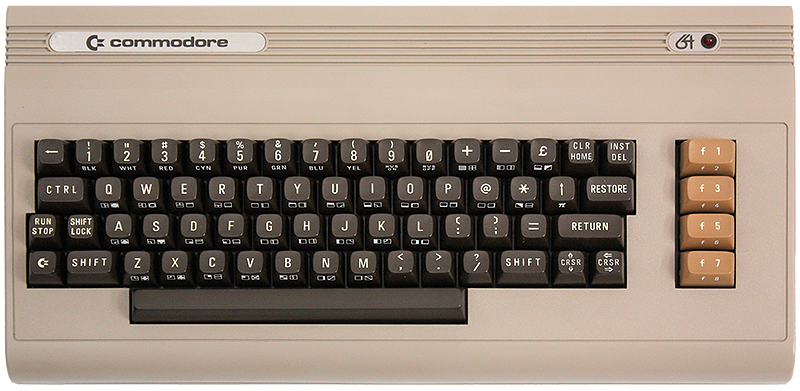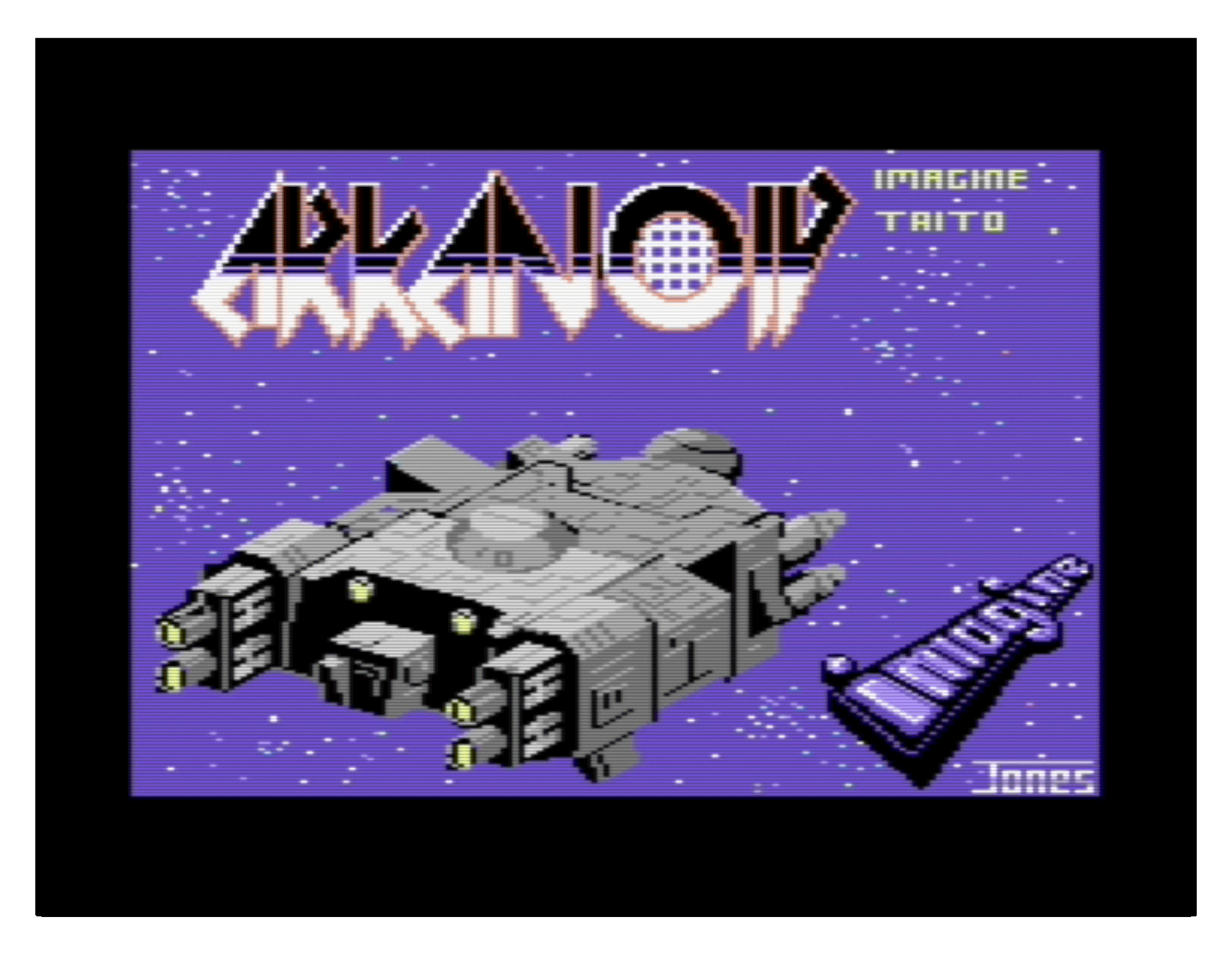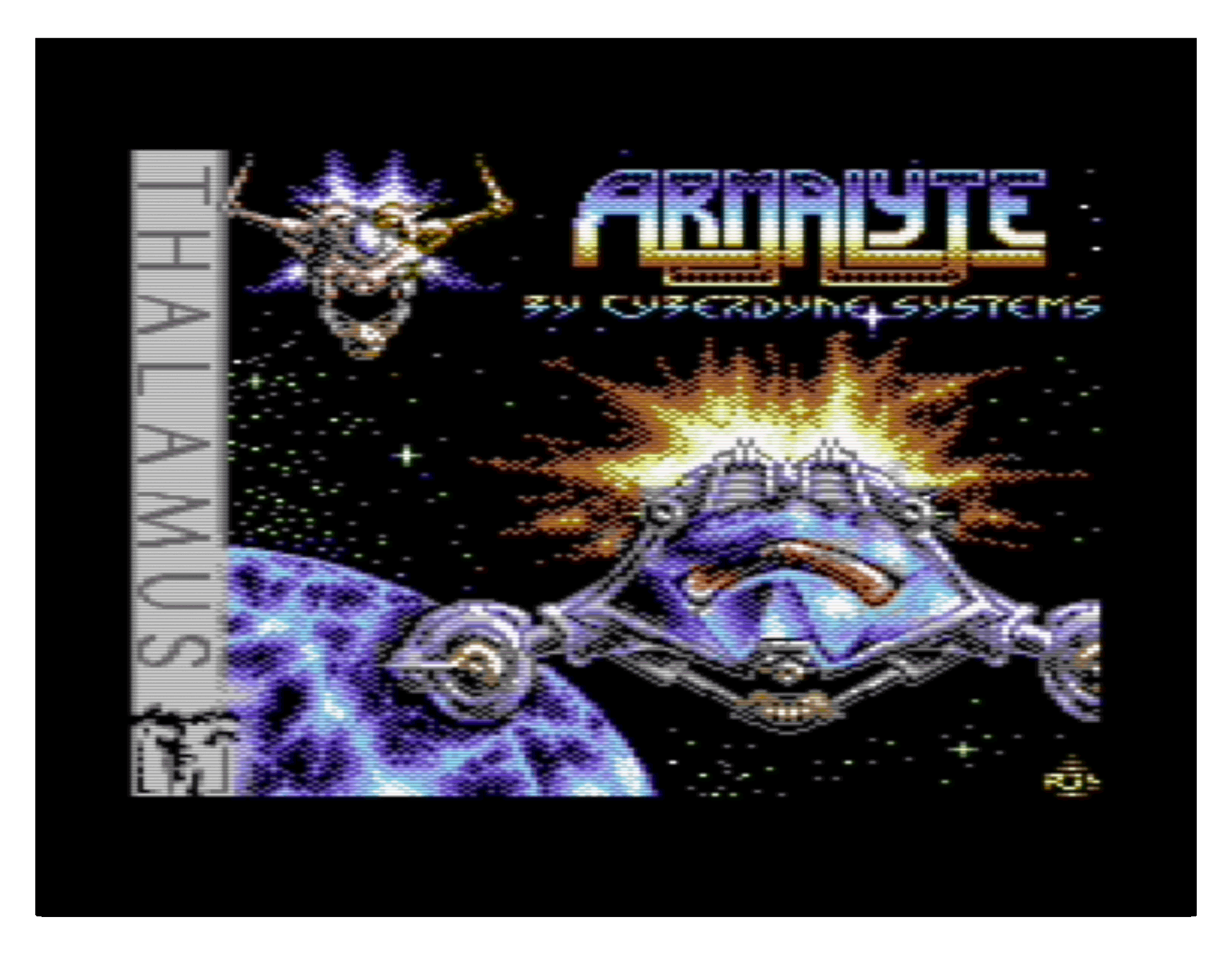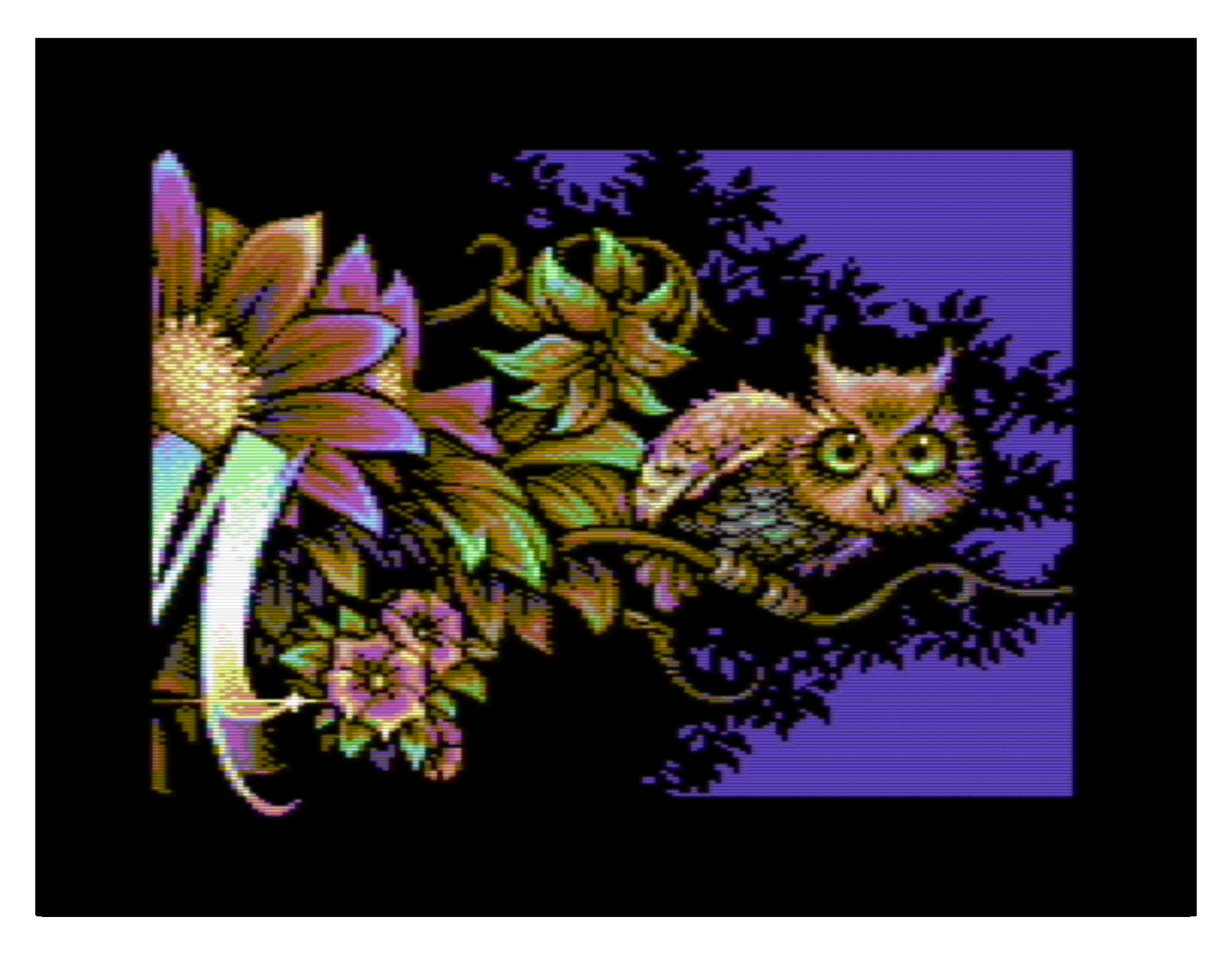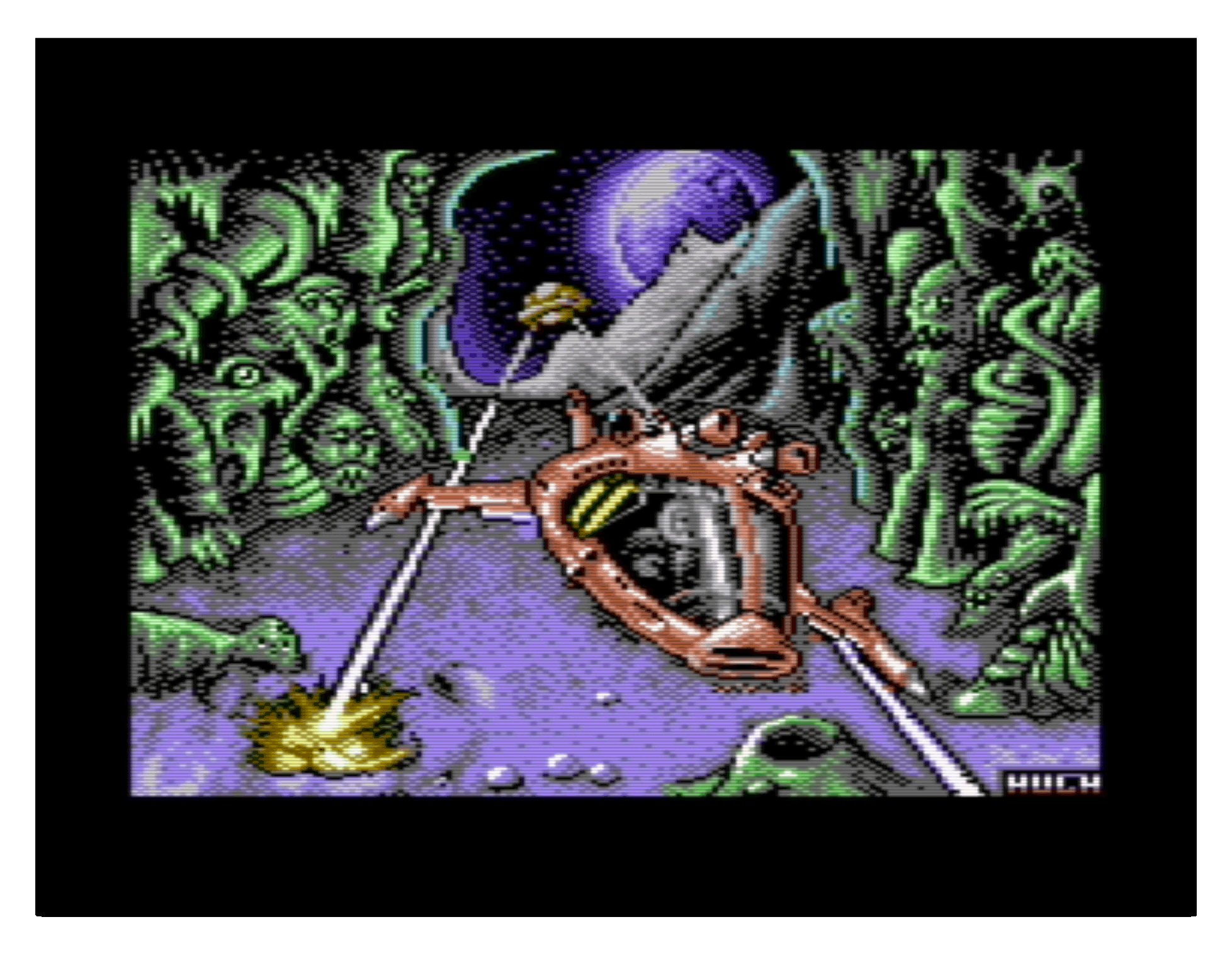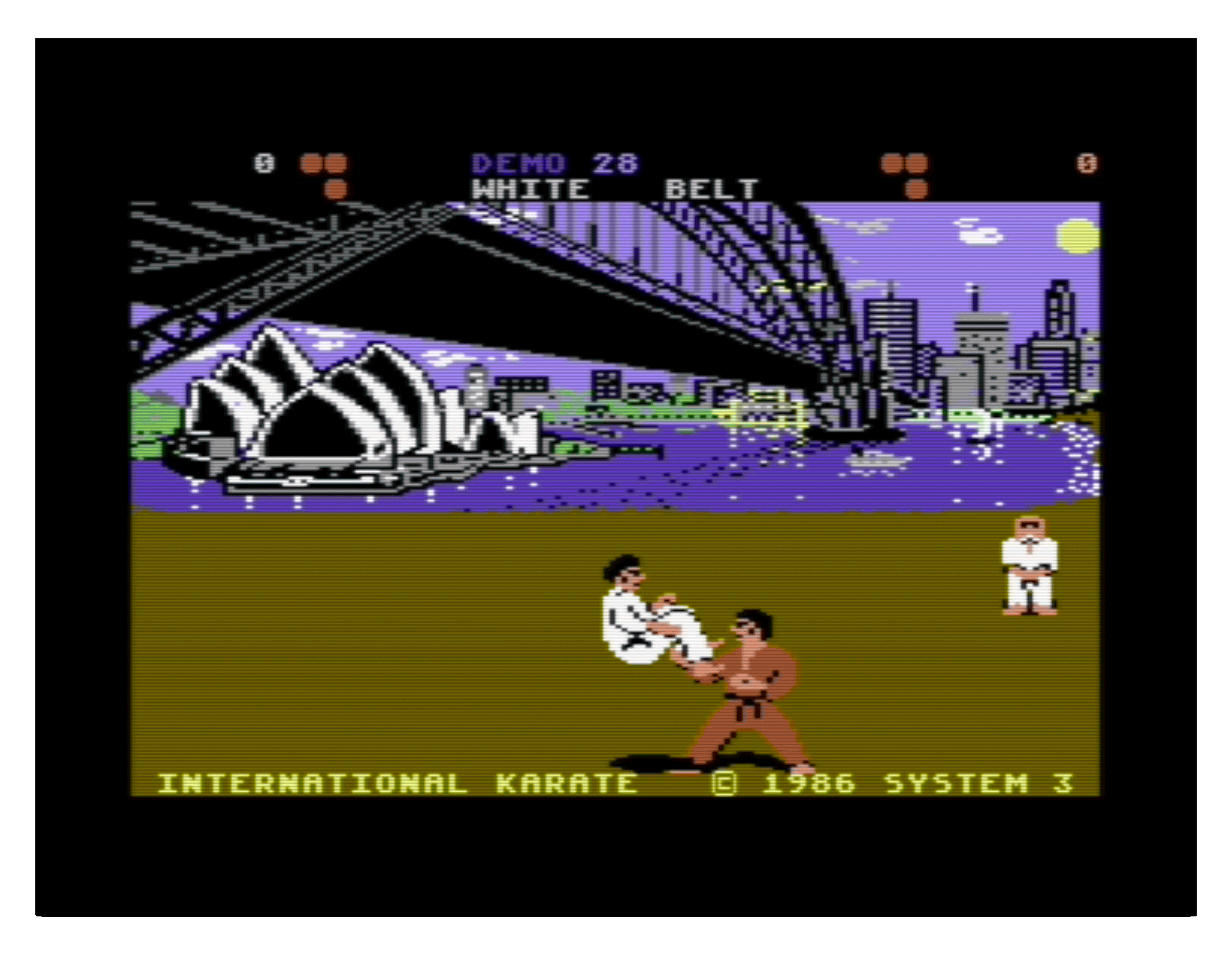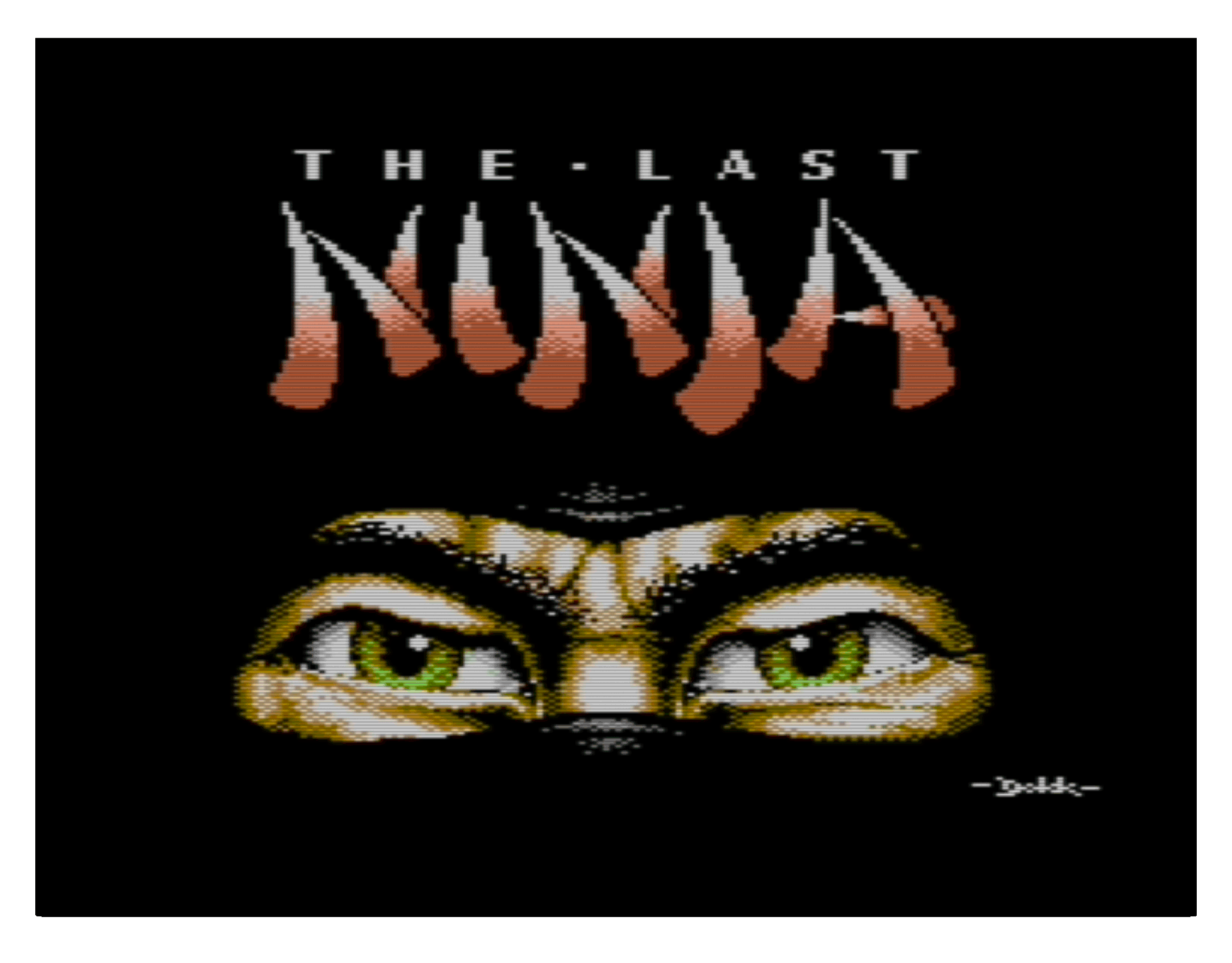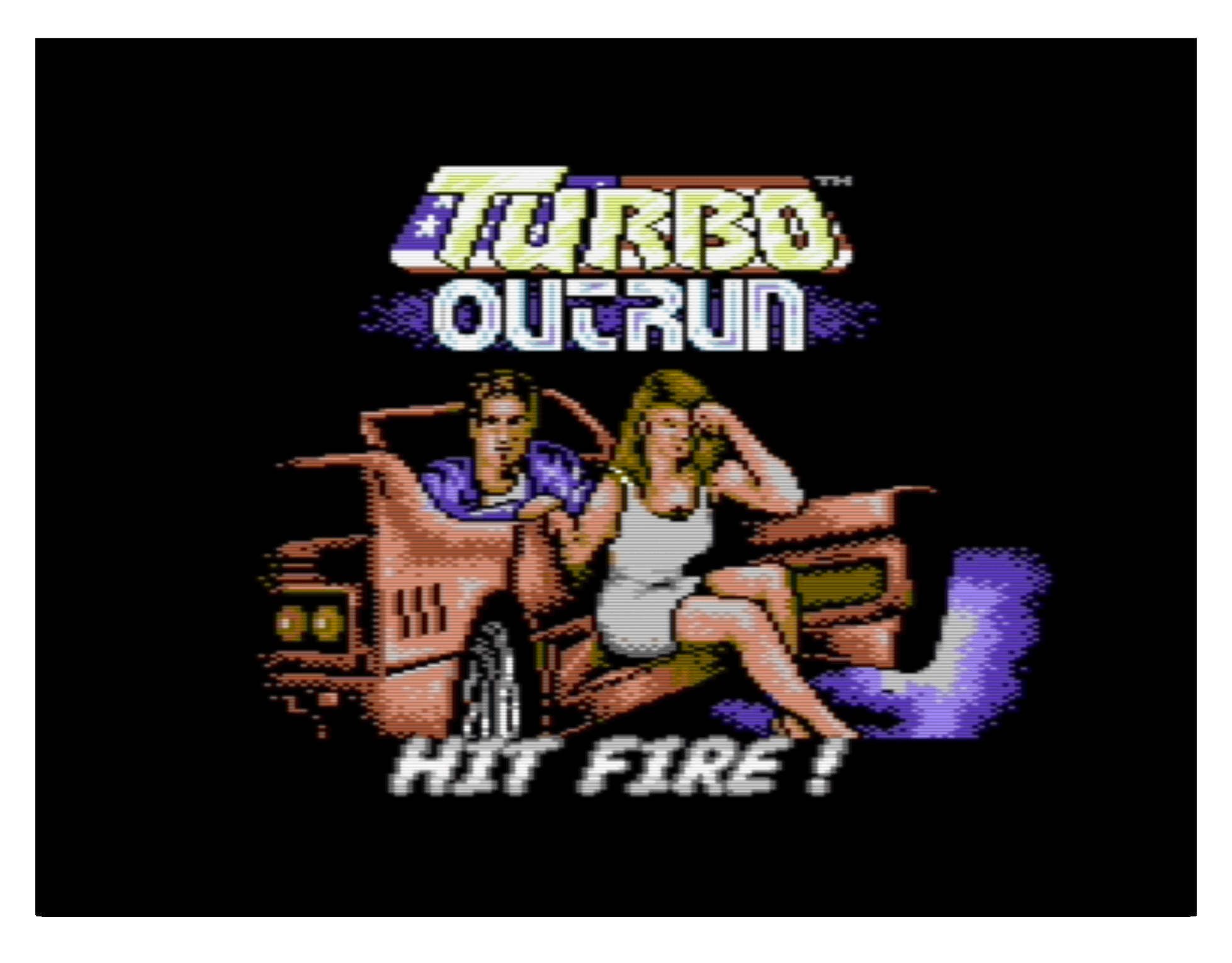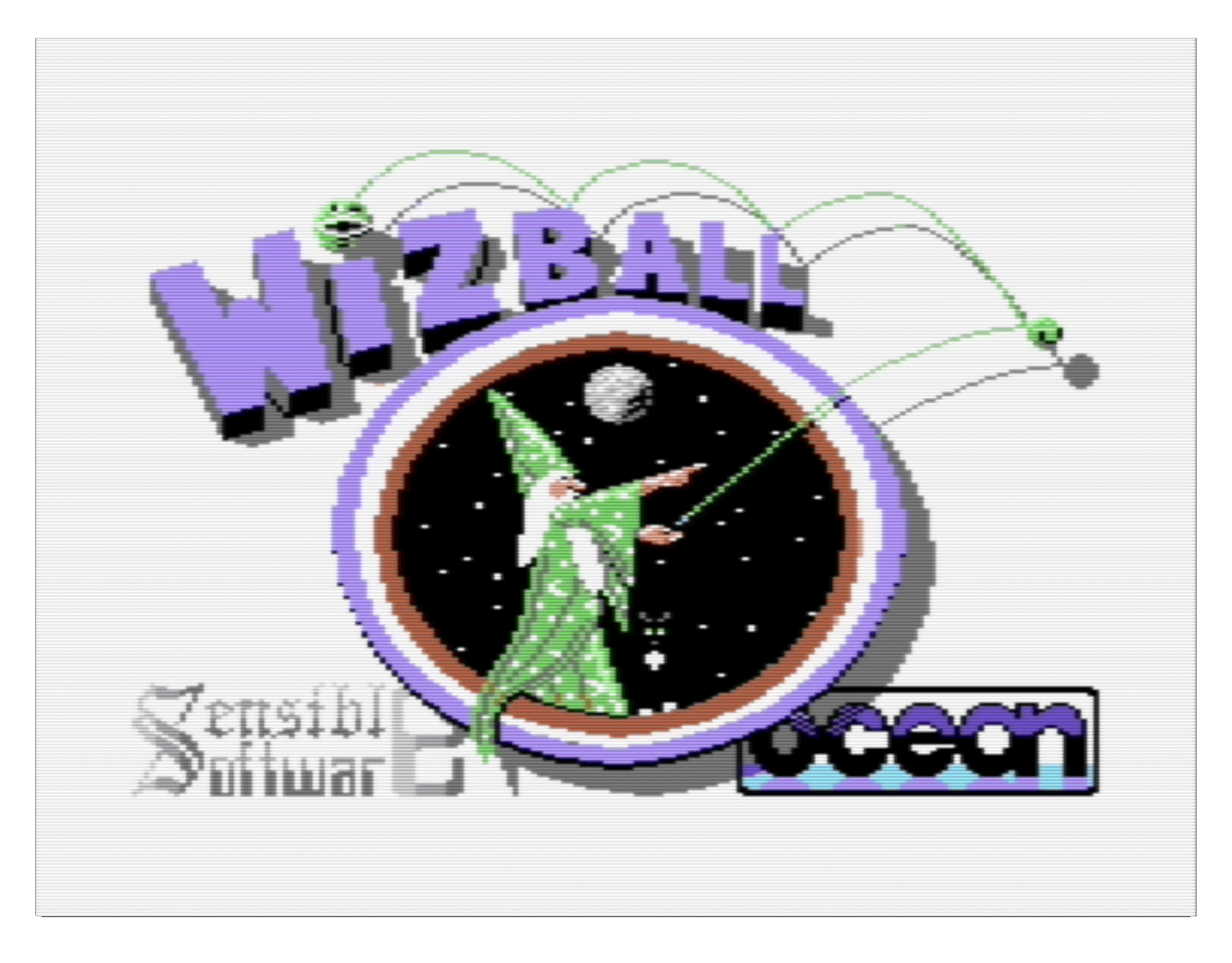256 COMMODORE 64 SID TUNES
Lo-Fi Music Recorded In Hi-Fi
Hi-Res Audio
Mastering grade (24 bit 96 kHz FLAC)
CD standard (16 bit 44.1 kHz WAV)
Casual playback (320 kbps 44.1 kHz MP3)
Handpicked SID Chips
6581 R2, R3, R4, and 8580 R5 chips
Matched chip and filter caps for each tune
Personally approved by some of the finest composers
FAVORITES AND HIDDEN GEMS
The USC contains most of the commonly recognized top 100 SID tunes, but also dozens of hidden gems, classic crack intros and brilliant demo tunes.
Browse the USC PDF before downloading the collection or check out the examples below.
SUPPORT THE C64 COMMUNITY
The USC donates on a monthly basis to the High Voltage SID Collection, the repository for all C64 music data, as well as other initiatives
USC TIMELINE
C64s acquired
3 x C64, 3 x C64C Long board, 3 x C64C Short board, 1 x C128
More SID chips acquired
10 x 6581 R2, R3, R4, R4 AR
Filter test written
Filter routine by Scarzix for spectral analysis
Test recordings approved
Ben Daglish, Jeroen Tel, and Martin Walker approved their chips of choice
USC compiled
Listened to 11.000+ tunes and selected 256. Finalized @ CHCC '19.
PSID script written
PSID > PRG batch script by Lagerfeldt, Ace_DK, and Idefix @ CCC meet
Capacitors + PSU upgraded
A range of PSUs tested. Improvements to filter offset and noise.
Recorded 256 tunes
In the Online Mastering DK studio
Audio gold mastered
Spectrally noise reduced and mastered audio
256 custom screenshots
A representative screenshot was created for each tune
Pre-launch on Boar's Head Tavern BBS
Lo-fi music in hi-fi to the elite @ byob.hopto.org:64128
Public launch
Lo-fi music in hi-fi to the masses
The Royal Danish Library
The tunes, including full composer credits, will be added to the permanent royal music collection
COLLECTION BACKGROUND - FAQ (1/3)
The philosophy behind this collection
Who’s behind the Ultimate SID Collection (USC)?
My name is Holger Lagerfeldt. I was born in 1974 in Denmark.
In the 1990s I worked as a major label producer and songwriter. My first million selling track “This Is How We Party” for Sony Music was loosely inspired by the SID tune Dan Dare III by Jeroen Tel.
Today I work as a mastering engineer at my own company Online Mastering.
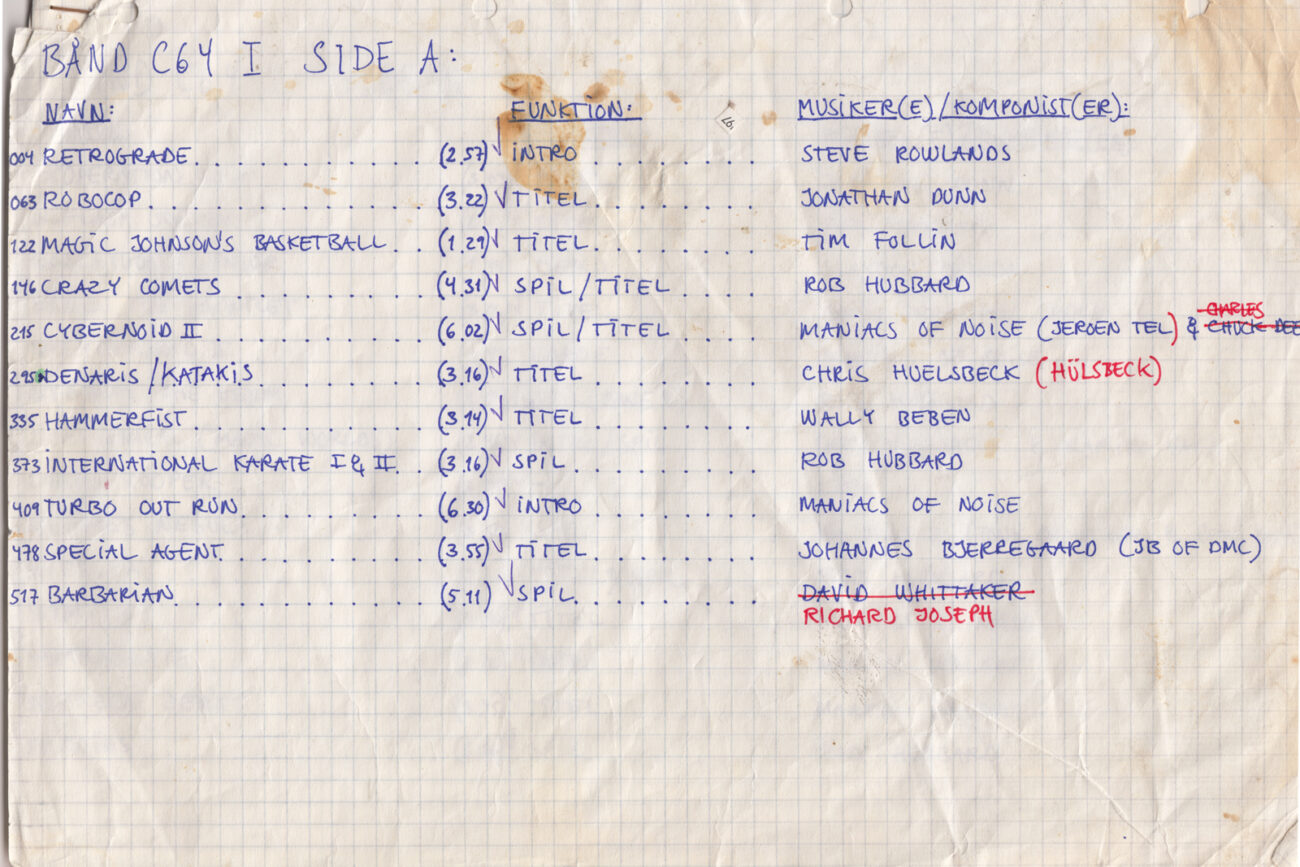
My 1990 cassette tape notes for SID music
As a child I listened to SID tunes on my C64 every day. I also recorded the tunes to cassette tape to hear them on my Walkman.
The tunes were often catchy and funky, and seemed like technical wizardry to me. I researched the composers and kept track of the information on sheets of grid paper.
As an adult I have been on a quest to recapture the original C64 sound that spellbound me as a child – and still keeps me hanging on. And so the USC was born.
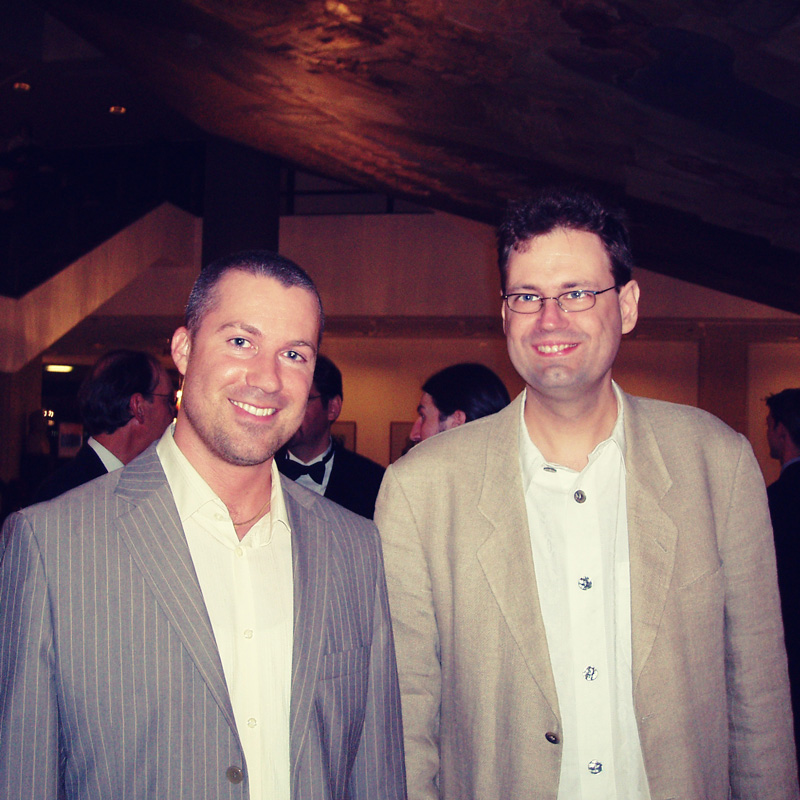
Holger Lagerfeldt and Chris Hülsbeck in Leipzig, Germany, 2005
In 2013 I was hired by producer Thomas Böcker of Merregnon Studios and producer Jan Zottmann to record and re-master the original Commodore Amiga, Super Nintendo, and Mega Drive music for the Turrican soundtrack anthology by Chris Hülsbeck. The project was produced with great attention to detail, and proved to me how big the fanbase is for retro computer music.
I also had the privilege of working on a range of other retro related projects, such as Instant Remedy’s Amiga music re-make album “Insert Disk 2”, as well as hobby remixing C64 tunes on RKO myself, e.g. Dutch Breeze/RoboCop 3 (Lagerfeldt’s Progressive Uplift Remix).
Why are there 256 tunes?
The exact number 256, rather than e.g. 250, comes from the number of steps in an 8 bit process (2 to the power of 8 = 256), the C64 being an 8 bit computer.
The USC is a curated collection that uses a handpicked C64 and SID chip for each tune or composer in order to focus on musicality and fidelity. Many tunes had their particular C64/SID combo approved by the original composer.
A real C64 sounds more gritty and perhaps slightly warmer than emulators. This is mainly due to the analog filter, so only real C64s with real SID chips would satisfy my quest.
Each tune went through a series of manual recording and processing steps that took considerable time, but resulted in higher fidelity than an automated process. This set a limit on how many tunes I could include, although the 256 tunes do add up to 15 hours of music in total.
The process each tune went through is described in details in the “Practical Process” section further up on the website.
Why are most of the tunes from 1984 to 1996?
The golden age of C64 music began in the mid 1980s and ended in the mid 1990s, which is why the USC is focused on this time period.
Many tunes of high production quality are still being produced today, and a dozen from the late 1990s and 2000s were included in the USC for their technical and/or melodic qualities, e.g. Vortex, Neon or Comaland Opening.
What were the criteria for making it into the USC?
The USC contains many of the tunes from the top 100, as often voted by the C64 community. Making it into the unofficial top 100 is a combination of a tune being catchy and original, well produced, or an above average tune or a (partial) cover version catapulted to fame via the game it was attached to.
The USC also contains historically important tunes or purely melodically interesting ones, although they might not be of high production quality, e.g. Bruce Lee and Spy vs Spy, respectively.
And perhaps most importantly: Demo tunes make up 25% of the USC. Some of the most recognizable tunes are often missing from so-called “Best of SID” lists because they only focus on games.
Why is my favorite tune X by my favorite composer Y not in the collection?
The USC aims to be a balanced, representative collection with something for everyone, but it is also a curated collection. This means personal taste and nostalgia play a role, too.
Please visit the inspiring SOASC project if you are interested in a non-curated, automatically recorded collection with a focus on quantity. SOASC is now discontinued, but remains as a historical archive.
Why isn’t emulation good enough?
Emulation player and filter programmers such as Simon White, Dag Lem, Antti Lankila, and Andreas Varga have done an amazing job in recreating the unique sound of the SID chip on modern computers.
However, the SID is a mixed-signal circuit, i.e. a hybrid digital/analog unit. It is difficult to emulate the analog filter sound. It is also tricky to emulate the unpredictable distortion characteristics of the field effect transistor.
There is nothing wrong with emulation per se – in fact without the opportunity to easily test songs and curate playlists in SIDPLAY there would not be an Ultimate SID Collection.
Why doesn’t tune X sound 100% like I remember it on my own C64?
Most likely because the filter in the 6581 chip in your C64 breadbin or early C64C long motherboard was overfiltered or – a less likely – underfiltered.
It could also be that you owned a late C64C short motherboard with a 8580 chip which sounds underfiltered with some tunes and cannot playback samples using the DC bias exploit.
There is no accounting for taste and nostalgic memories, but the SID and filter sound for each tune in the USC was carefully selected based on both historical available data (e.g. Project Galway from C64 Audio), technical reasons (e.g. the deepest applied filter setting in Rob Hubbard’s Lightforce) or on my experience and taste as a producer and audio engineer – or it was the unassailable choice of the original composer, having approved this particular sound himself for the USC.
Without wanting to sound arrogant, it is safe to assume that the sound in the USC is as close to ideal as possible.
Why are some tunes looping and fading and some not?
As a mastering engineer of a wide variety of music styles my approach to the USC was to treat these tunes as instrumental pop or electronic songs.
This means evaluating whether a tune should to be looped once or twice or faded before or after the loop point. Some tunes have built-in low resolution fades, in which case I have kept those built-in fades instead, even if they taper off slightly abruptly. This is not an oversight, but how the tune was faded by the composer due to the technical limitations of the original hardware.
Most tunes play from start to finish or longer (i.e. loop), while a handful or fewer were faded earlier if the ending seemed repetitive or activated an ad naseum loop (e.g. Comaland Opening). A single tune, Edge of Disgrace, is actually made up of several quasi-rearranged segments from the original demo, and was faded a bit past the 9 minute mark to keep the length reasonable in this collection.
What does “mastering grade” mean and why?
It means that the recording and restoration processes were performed to music industry archival standards using state of the art equipment, and conformed to best practices by a professional audio mastering engineer.
The standards applied are practically overkill for recording 8 bit retro music, but the higher the quality of the original recording, the better all final target versions (CD standard and lossy formats) will be as well.
Also, from an early stage this collection was intended for inclusion in The Royal Danish Library’s music collection, which means it needed to be of archival quality.
Finally, this is the first SID collection where all tunes can be played back to back or in random order with matching loudness. An integrated LUFS measurement can be used as a starting point for each tune, but it will often be 2-3 dB off. Loudness is a psychoacoustic phenomenon which requires a human – a mastering engineer – to set the relative perceived output level of each tune.
INFORMATION METHODOLOGY - FAQ (2/3)
How information for the USC spreadsheet was collected, sorted and prioritized
Spreadsheet
The USC spreadsheet is included in the downloads or it can be downloaded separately (see the “Favorites and Hidden Gems” intro section further up on this website).
USC #
A unique catalog number assigned to each tune in the Ultimate SID Collection.
It is based on alphanumerically sorted title names, with subtunes from the same game/demo subsorted by order of appearance, e.g.: Loader > Intro > Title > In-game > Level order
E.g. Bombo (Title + Level 2 – City) > Bombo (Level 1 – Egypt) > Bombo (Level 3 – Castle)
This information is based on HVSC as well as practical testing of each game/demo, since HVSC occasionally has incorrect info.
Screenshot
A representative screenshot. In most cases the screenshot was chosen based on the following order of prioritization: Loader or intro picture > Gameplay > Title screen.
Screenshots are not necessarily representative of the specific function of the tune, i.e. a loader picture could be used to represent the title tune or an in-game level.
In a few cases individual level screenshots have been taken if no loader or intro existed.
For demos or crack intros the order followed this order of prioritization: Composer specified demo, even if this is different from first registered use on CSDb > First use in a demo by year and month on CSDb > Estimated first use by year > Random demo using the SID.
The only exceptions are the three Ocean Loaders where the screenshots technically speaking should have been grabbed from a specific game’s loader – but this would be very confusing. For this reason I have chosen to use Nostalgia’s Ocean Loader Tribute as the screenshot instead.
Title
Generally the official title of the game (cover art/title screen) has been used, and for demos the name registrered in CSDb.
A few comments to specific titles:
- The full title of Astro Marine Corps is A.M.C.: Astro Marine Corps, but it is superfluous and rarely used, and so it is not used here either
- After Burner the arcade game is written in two words, although it often incorrectly appears as Afterburner in home conversions. The same applies to a couple of other titles with incorrect contractions.
- Hot-Rod appears correctly with a hyphen in the USC, although the hyphen is often missing
- Phantoms of the Asteroid is notorious for using three different title variations. I am using the one from HVSC.
- The use of Roman numerals (I, II, III) rather than 1, 2, 3 depends on the cover art or the title screen. This means Dan Dare III is not Dan Dare 3, although the latter is how the title appears in HVSC.
- Subtitles or taglines have generally been omitted, i.e. “Double Dragon II: The Revenge” appears as merely “Double Dragon II”. The exception is “Deliverance: Stormlord II” because there is another game called Deliverance.
Function
Loading screen, intro, title, in-game, high-score, game completed or demo. Sourced from HVSC and/or from practical testing since HVSC is occasionally wrong or has missing info.
Duration
Duration of the tune in the USC.
This could be longer than in the HVSC (because it was looped and then faded in the USC) or in a few cases shorter (because it was faded early before looping or ending).
Arranger / Composer
If only one name appears, this person is both the arranger/producer and composer.
A name or initials in brackets is the composer’s handle, i.e. nickname. The handles have been sourced from DeepSID. Deprecated handles have not been used, e.g. Benn for Ben Daglish, even though it was historically correct at the time of release.
Example of single arranger/composer credits:
Closing In
Jeroen Tel (WAVE)
Since only one name appears it means that Jeroen Tel (handle: WAVE) is the sole arranger/producer and composer of this tune.
If the song is a cover version then more than one name will appear, the first name being the arranger/producer and the second being the composer.
Example:
1942
Mark Cooksey (MTW) / Ron Goodwin
Cover of the main theme from the movie 633 Squadron
Since the additional information specifies that this is a cover verson it means that Mark Cooksey arranged and produced the tune, and it was composed by Ron Goodwin.
If more than two names appear in a cover version, then the first name is the arranger/producer and all subsequent persons are co-composers.
Example:
Combat School
Martin Galway / Abigail Mead / Nigel Goulding
Cover of “I Wanna Be Your Drill Instructor” from the movie Full Metal Jacket
Since the additional information specifies that this is a cover version it means that Martin Galway arranged and produced the tune, and it was composed by Abigail Mead and Nigel Goulding.
If the song is only a partial cover version or “inspired by” in some form (see additional information) then the first person is the arranger/producer and co-composer while subsequent persons are co-composers.
Whether something “contains a reference to” or “contains an excerpt of” or is “inspired by” or “loosely inspired by” is a matter of judgment, and this will affect the credits as well. I have used my 30 years of experience as a professional songwriter and producer to estimate the level of inspiration and when credit is due.
If more than one person appears as the arranger/composer but it is not a cover version (i.e. no cover version note in the additional info field) then it means they are both/all co-arrangers/co-producers and co-composers.
Example:
Angel
Thomas Danko (Danko) & Jesper Värn (Decoder)
Since the additional information does not specify this is a cover version it means that both are co-arrangers/co-producers and co-composers.
Hopefully everything is clear as mud now!
Release
The release year is straightforward with games: HVSC is the main source of information here, although I have double-checked with Wikipedia and other sources. A release year specified in the actual game is not necessarily correct, since many games were programmed in one year and published the next.
When it comes to demos it is a lot more tricky, but generally the HVSC release year has been used.
In some cases I have found an earlier use of a demo song on CSDb and have changed the release year in the USC. However, ultimately it is up to the composer to decide what the release year is, i.e. the tune could have been leaked and used without permission in an earlier demo, and the composer prefers this not to count. For this reason I have contacted several composers and asked them if they remember the exact release year.
This means a couple of demos have a slightly different release year than in the HVSC or on CSDb.
Publisher
Publisher name, affiliated demo group or self-published. The main source is HVSC, but a few demos have been re-attributed based on direct composer or CSDb info.
Almost all commercial C64 game publishers are now defunct, which means mechanical rights to the music have technically reverted to the original composers and/or the publishing rights are represented by C64 Audio for potential commercial use. Bangkok Knights, Dominator, Flimbo’s Quest, International Karate, The Last Ninja series, and Myth games software and screenshots are © System 3 Software.
Additional info
Additional information is usually related to cover version information, demo sources or this field contains a more detailed description of the tune’s function, such as an additional tune title or whether it was used for a particular game level.
HVSC subtune
Subtune # in HVSC. The order or number does not necessarily correspond logically to how a tune was used or placed in a game.
C64
C64 model used for this recording, filter cap values (if relevant), and internal USC codename.
SID
SID chip, revision, production date and internal USC codename used for this recording.
TECHNICAL BACKGROUND - FAQ (3/3)
The technical side of this collection
Defining sound quality
First it is necessary to define what “sound quality” means when it comes to Commodore 64 music.
Desirable artifacts are to many what makes the SID chip sound the way it does. While the designer of the chip, Robert (Bob) Yannes, might consider these artifacts design or production errors, they are in fact integral to the character of the SID.
The major revision from the 6581 to the 8580 chip would rectify some of these technical errors, but in the process cause older tunes to sound quite different or to lose sample playback.
Please take note: When nothing else is mentioned I am referring to a 6581 SID chip in a PAL C64 or early PAL C64C long motherboard.
Mythbusting the 6581 revisions
Before coming back to defining sound quality I wish to address what appears to be a stubborn myth: that each 6581 revision has an identifiable sound because of its revision number.
I am not saying that 6581 chips do not sound different to each other. I am saying that the difference is not related to the revision number itself, and that the sound is not identifiable based on the revision number.
I have found no empirical proof of significant or easily identifiable sound changes between 6581 revisions simply because of the revision number, i.e. R2, R3, R4 and R4 AR.
This means an R2 does not per definition sound more open than an R3, and an R4 does not per definition sound fatter than an R4 AR or vice versa – or any other proposed property of a certain revision.
Whenever someone claims there is an inherent and identifiable difference in sound between revisions because of the revision number itself, it is purely anecdotal.
Differences between 6581 chips
So why are there sound differences between 6581 chips?
The explanation is that there are production tolerance issues with the filter components and transistors. This causes 6581 chips to sound different to each other. This has nothing to do with the revision number itself, but is related to the production tolerances of batches, as corroborated by Andreas Varga’s (aka Mr. SID) August 1996 interview with Bob Yannes.
Even within the same batch there are tolerance issues, but much less so than between batches.
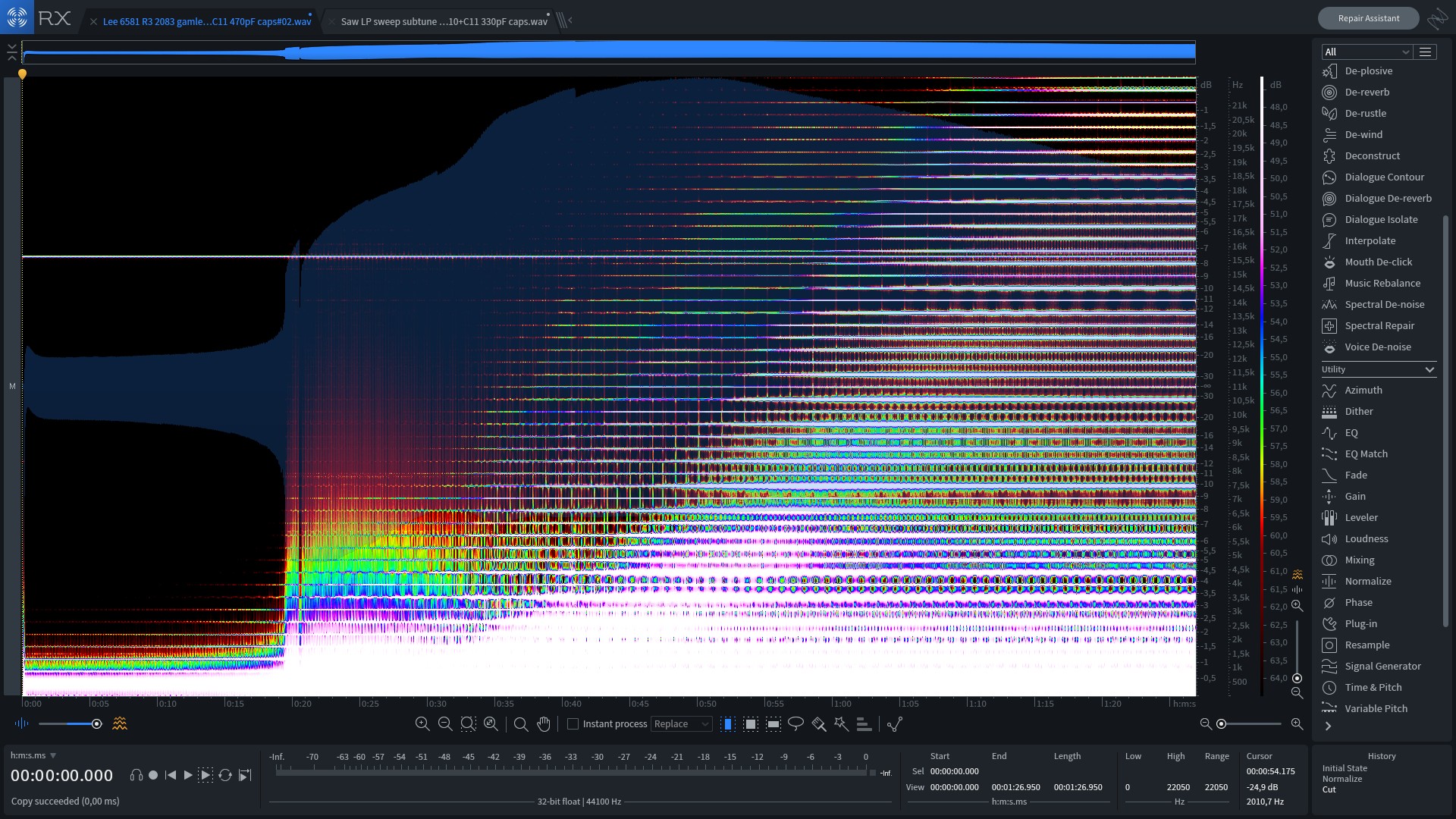
Spectral analysis of a SID filter BEFORE capacitor fix (470 pF bad/old/offset caps)
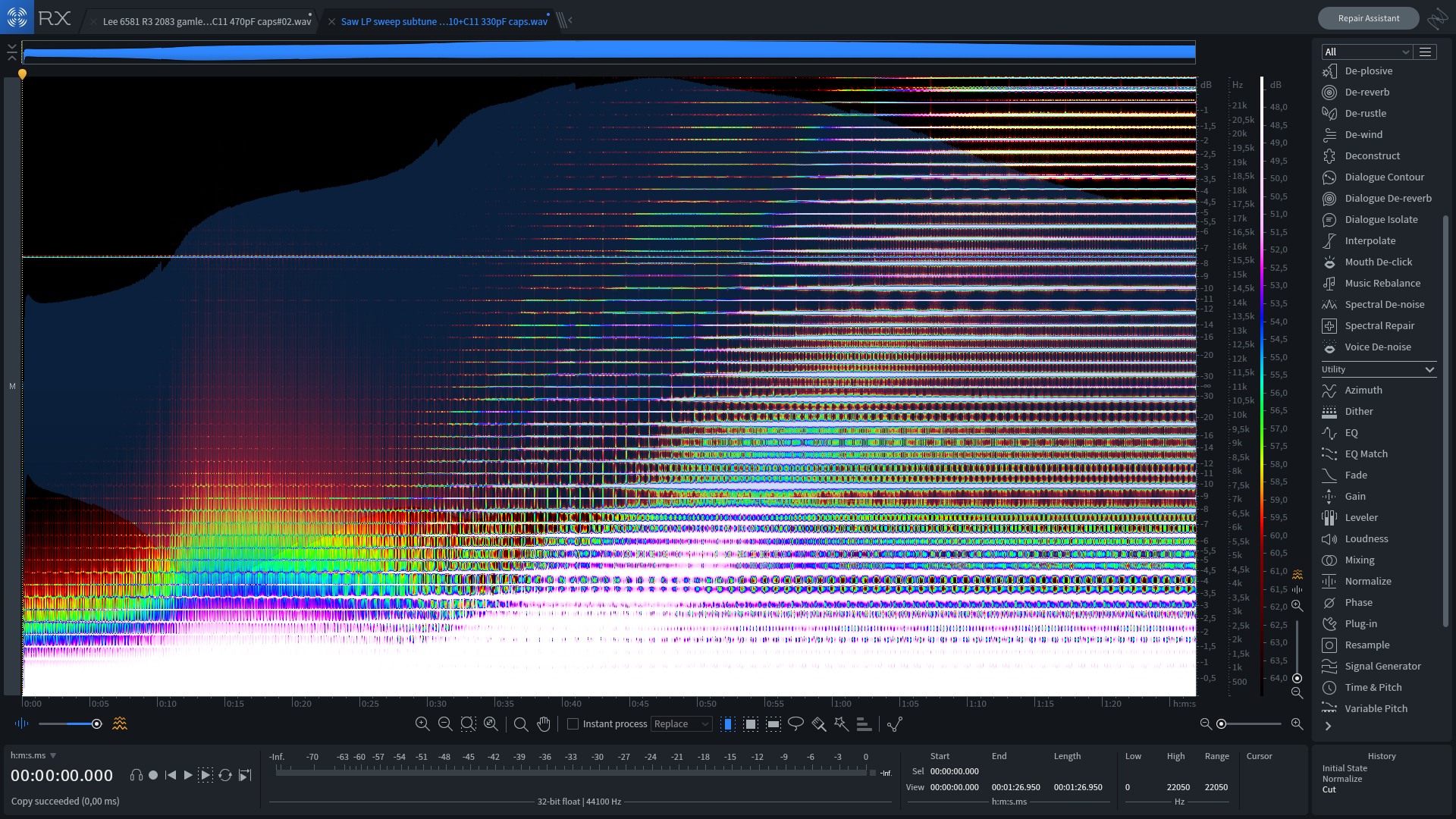
Spectral analysis of a SID filter AFTER capacitor fix (new 330 pF caps)
Conclusions on differences
For the creation of the USC I purchased three C64s (6581), three C64C long boards (6581), three C64C short boards (8580) and one C128 (6581). I also bought an additional ten 6581 chips for a total of 20 different SID chips, which I subjected to full spectral analysis, including custom programmed sweeps of the filters.
Based on the empirical data from the 20 SID chips it is my conclusion that:
- There are no inherent and identifiable differences that can be attributed purely to the revision number of a 6581 SID chip
- The differences between batches of the same revision can be larger than the differences between revision numbers (read that twice)
- There can be differences within the same batch, but less so than between different batches
- The ceramic filter caps at C10+C11 in the C64 play an important part in the filter offset point – regardless of the actual fitted SID (see the comparison screenshots up in the “Differences between 6581 chips” section)
The last point also means that you cannot judge or measure SID chips in the same and especially in different C64s without using SIDFX 3 or first performing recaps, since the pF value and decade loss of the ceramic filter caps in each C64 machine affect the SID chip’s filter sound significantly.
More about the caps and and SIDFX later in this FAQ.
To be fair to those with stubborn anecdotal “evidence”, it is entirely possible that more batches with a certain sound were produced of certain revisions, which could lead people to conclude that it was the revision number that was the reason for a change in sound. But it should be clear now that the real answer is a bit more nuanced, since the differences between batches of the same revision number can be larger than the differences between two random revision numbers.
How the conclusions affect the USC
I am beating a dead horse now, but remember what the Good Book says: He who rejects a specific 6581 revision at face value has not peformed his due dilligence.
For this reason it is more important that a 6581 revision sounds optimum for a particular tune or composer than it is for the chip to be historically accurate purely from a timeline perspective.
In other words: it is irrelevant whether a 6581 chip used for a tune was produced before or after the actual tune was composed, as long as it sounds right for the job and/or was approved by the original composer.
Artifact categories
Coming back to defining sound quality on the C64: artifacts from an audio engineering persepctive fall into one of two categories: undesirable and desirable.
Undesirable artifacts
- A) Residual background noise, such as hiss, hum and whining
- B) Chirping interference and sync whine caused by the C64’s VIC-II graphics chip
- C) Loud initialization pops or other loud clicks
Let us go through the undesirable artifacts in detail and how to deal with them.
Undesirable artifact A – Residual background noise
Constant background noise is completely unrelated to the music, and the composer has no control over it. Therefore it would be impossible to consider it a desirable trait, except from perhaps a nostalgic standpoint.
Most of the background noise is caused by the ungrounded external audio input on pin number 26 on the SID.
The background noise is a combination of a low frequency mains hum at 50 Hz plus a full series of related overtones. It also contains a narrowband 15.625 Hz whine related to the video output, as well as general white noise hiss.
It can be dealt with in several ways, and probably more than these:
- Software assisted noise reduction, such as Izotope RX or Cedar Systems
- Software routing the external audio input into the filter
- Bending pin number 26 on the SID so it is floating and unconnected
- Soldering a ground connection on the PCB of the C64 to the audio input
- Soldering pin 2 (GND) and 5 (AIN) in the video port connector or in the cable placed into the video port
Solution 1 was chosen as part of the solution because it is effective and does not affect the music when done correctly, i.e. unique fingerprinting followed by high threshold spectral noise reduction.
Solution 2 was rejected because it ineffective, it affects the headroom of the filter, and requires altering the machine code.
Solution 3 was rejected because of the risk of introducing other types of noise and is not a stable solution.
Solution 4 was rejected because it cannot easily be reversed and solution 5 does the same with less risk.
Solution 5 was chosen in addition to solution 1 since it is easily performed and effective.
Two more noise reducing initiatives were performed:
- All power to the C64 and screen, as well as the recording equipment, was filtered through Furman P-1400 AR E power conditioners for even more clean and stable mains power.
- A PSU upgrade. I did a test between the original C64 PSU (-62 dB RMS A-weighted), a Ray Carlsen multi-unit PSU (-74 dB RMS A-weighted), and the Electroware C64 PSU (-77 dB RMS A-weighted) – the latter being the most quiet in my test.
An alternative solution to lowering noise earlier in the chain could have been to use the SIDFX 3, but for reasons related to my choice of soldering individual filter cap values per machine, which are overridden by SIDFX, as well as switching between several different machines, I chose not to use the SIDFX for these recordings.
The nominal noise floor of the recordings ended at approximately -77 dB RMS A-weighted, then RX reduced to approximately -89 dB ditto. The noise floor was then raised again on average by 3 to 5 dB by the final level adjustments, but it is still more than acceptable for any retro or analog sound source, on par with e.g. the finest tube gear, and much better than vinyl.
Undesirable artifact B – Chirping interference and h-sync whine
The VIC-II graphics chip produces electric interference of two sorts. One is a constant horizontal sync whine and the other is an interactive chirping noise related to the pixels on screen.
The whining and chirping are beyond the control of the composer and can be annoying to people with an above average hearing. This is another artifact which can not be categorized as desirable by anyone, even from a purist standpoint.
The chirping noise can be completely removed and the whine lowered by turning the screen off in the VIC-II chip and setting the background color to black.
The PSID64 conversion script produces controller software that manually (or automatically, if you so desire) allows you to blank the screen, which is what I did. A handful of tunes do not allow this, and furthermore it is not possible to blank the screen with tunes that need to be played from the original game/demo. These tunes required more manual RX’ing (more about RX later).
Residual whine can be removed with manual non-adaptive spectral de-humming set to an extremely narrowband 15.625 Hz + 1st harmonic.
Undesirable artifact C – Loud initialization pops or other loud clicks
When the SID is initialized, a loud pop or click will be heard. Typically this happens almost at the same time as the very first note begins.
This artifact cannot be said to have any musical value, but it could be construed as having some nostalgic value. However, I have decided that a loud click or pop in the beginning of each tune was ultimately undesirable from a musical and restoration standpoint, which superseded any potential nostalgia related to an initialization click.
Also, some composers were able to partially hide some other clicks by timing the root cause of these artifacts, so these clicks cannot unequivocally be considered purely undesirable. This is why automatic click removal is not an option with SID tunes, and why I have only performed manual click removal on initialization pops and clearly arbitrary, loud clicks in the middle of some tunes.
The way to remove the initialization pop without affecting the first note is to use manual full frequency spectral repair with maximum “before” weighting. This uses the quiet left side of the pop for the interpolation process and leaves the right side, containing the first note, untouched.
If it is done incorrectly, such as an automated process or with centered or “after” weighting, it will ruin the crisp attack of the first note. This is audible in some other collections which either use default center weighing or an automatic fade in.
Minor clicks inside the tune itself can either be ignored or be treated with center weighted frequency selective (as opposed to full frequency) spectral repair with a maximum of 128 bands in order to minimize interpolation artifacts in the time domain.
Especially the latter can be very time consuming on some tunes, e.g. Katakis by Chris Hülsbeck.
Low end bumps are best repaired with a tweaked multi-resolution repair or partials & noise algorithm to avoid smearing.

SID composer Chris Hülsbeck in the mid-1980s
Desirable artifacts
- D) Nonlinear filter slope with severe leakages at certain points
- E) FET output saturation
- F) DC voltage bias exploit
- G) Combined waveform phasing due to a logical AND error in the 6581
Desriable artifact D is the nonlinear filter slope. It has a generally logarithmic slope with several unusual nonlinearities where the filter “leaks” sound, causing a frequency warbling effect when the filter is sweeped.
Since the intensity and specific area of these leakages are not always the same in each chip it is difficult to consider this a completely desirable artifact, but it does give the filter a unique sound property.
Desriable artifact E is field effect transistor saturation. This is an indirect result of the NMOS design of the 6581 which sends the DAC control voltage into FET resistors. FET resistors were used in vintage studio gear like the 1176 LN limiter/compressor used extensively on Michael Jackson’s Thriller album. It plays a part in the harmonic saturation, in other words a “fattening” or enrichment of the sound.
In the SID this saturation effect is exponential, with a large increase near the maximum output range, approaching hard clipping.
Desirable artifact F is caused by a direct current bias, i.e. an inherent offset from the zero point during amplification. However, when a composer rapidly manipulates the gain signal using the 4 bit volume register it is possible to create a low resolution pulse code modulation signal. This in effect enables a virtual fourth channel, usually reserved for low quality drum or short speech samples.
It is important to notice that the C64 has no way of normally playing PCM sound, such as a WAV file. The DC bias exploit is a small glimpse into the ingenuity of the early SID composers, and in fact composers have kept inventing small technical miracles way into the 2020s – on a home computer released in 1982!
In the later 8580 revision this design error was drastically reduced, in the process crippling sample playback on newer C64s, and causing a serious backwards compatibility problem. Several other sample playback techqniues were later developed by composers, all of which are compatible with all C64s.
The last desirable artifact is G – combined waveform phasing. Again something that was fixed in the 8580, which means older tunes may not playback as intended on newer C64s. Due to an implementation error in the so-called logical AND operation in the 6581, combining identical waveforms can result in nulling or partial phasing.
This can be used as an intentional effect or it can lead to the sound cancelling out with 6581s, but not with 8580s.
There are other minor challenges with the SID synthesizer design, but some were addressed in software by the composers, such as the invention of the hard restart for oscillators.
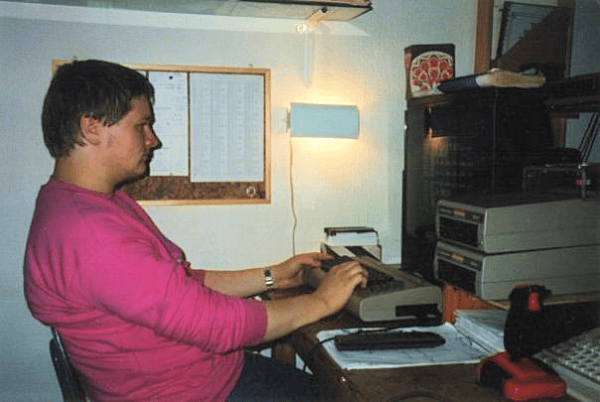
Chordian aka JCH (@ DeepSID) coding in 1988
Identifying SID chip revisions
Commodore was notorious for using old spare parts when making new or repairing computers. Do not expect to be able to precisely identify a SID chip revision simply based on the C64 case or assy number.
A quick ID tip
However, it is at least possible to guess from the outside if a C64C/C64-II (often white/beige) contains the old 6581 or the newer 8580 chip.
The first thing is to look at is the keyboard. If the keyboard has the PETSCII characters printed on the front facing part of the keys (and not the top) then it is likely an early long board model with a 6581 chip.
A change of law in Europe, designed to help the visually impaired, forced Commodore to move the PETSCII characters to the top of the keyboard, right next to the alphanumerical characters. Ironically this made the characters even more illegible. C64s with this keyboard design usually have 8580 chips.
The above technique can make it easier to make a qualified purchasing decision on badly documented online sales of C64s.
If you have physical access to the C64, but are too lazy to open it, then look through the expansion port. Early long board C64Cs (with 6581) have the fuse placed across/sideways, while later models (with 8580) have the fuse pointing forward.
Identifying a specific SID revision and batch
Make sure you have discharged static electricity from your body before opening a C64.
Once you have opened the case search for the SID chip. Some SIDs will say CSG or MOS or simply bear a small Commodore logo as well as the model number (e.g. 6581 or 8580).
The production date is revealed on the top of the chip. The format is WWYY, i.e. week number and year. So 2083 means week number 20 in 1983. This means 1184 is a newer chip than 2083.
If you want to remove or switch out SID chips (remember the 6581 and 8580 are not interchangeable) then preferably use a chips puller or, if you are lazy, very gently wriggle a flathead screwdriver below each end of the SID to lift it up. It is important not to bend or break any of the legs. Take note of the direction the chip was placed and make sure you apply even pressure when you put it back in.
Some of this info is from Wikipedia (unfortunately C64-Wiki does not contain updated info AFAIK, so consider this page or Wikipedia more correct), some info is from The Danish Historical Data Association. If you are a Wikipedia or C64-Wiki editor please feel free to include any new info you find here, preferably with a source link to https://ultimatesid.dk
6581 R1
Identification:
An internal prototype produced in very limited quantities.
Production dates:
4981 to 0482
Appears in:
No R1 revisions exist in commercially sold C64s
6581 R2
Identification:
The first production line SID. Has the number 6581 printed on the top of the chip. R2s often become hotter than other revisions and are more susceptible to external forces. Treat them with extra care.
Production dates:
1182 to 1483, with an unconfirmed grey zone from 1583 – 1983. It is prudent to assume that chips later than 1483 are not R2.
Appears in:
Commodore 64 (silver label)
Commodore 64 (breadbin)
Commodore MAX/VC-10/Ultimax
USC:
The 6581 R2 used for the USC is a 4982 (internal codename “Thriller”) placed in a C64 breadbin (internal codename “Goldie”) with 470pF filter caps for a balanced, slightly open sound.
Interestingly this is exactly the same batch number that SOASC uses for their actual R2, after discovering the original “R2” used for the recordings up until 2015 was in fact a misidentified R3.
This “Goldie 440pF”/“Thriller” combo was used for a variety of tunes, including most Martin Walker and Richard Joseph tunes, and a single Chordian tune, Super Oswald, which seemed to benefit from this slightly more open filter sound.
6581 R3
Identification:
Has either 6581, 6581 R3 or 6581 CBM printed on top.
Production dates:
2083 to 1386
Appears in:
Commodore 64 (breadbin)
Commodore SX-64/VIP-64/Executive 64
Commodore 128
Commodore 128D (not DCR)
USC:
The 6581 R3 used for the USC is a 0686 (internal codename “Challenger”) placed in a C64 breadbin (internal codename “Goldie Rev 2”) recapped with 330pF C0Gs to change the filter offset.
This leads to a very open filter sound, which is exceedingly rare in the wild. It sounds nearly identical to the sound of Martin Galway’s own R3 chip transplanted into his development C128D, as documented by the Galway Project from C64 Audio.
This “Goldie 330pF”/”Challenger” combo was used for all Martin Galway tunes. It is also used for any Rob Hubbard tunes from approximately mid 1986 that apply the filter, such as Lightforce, which require an equally open filter.
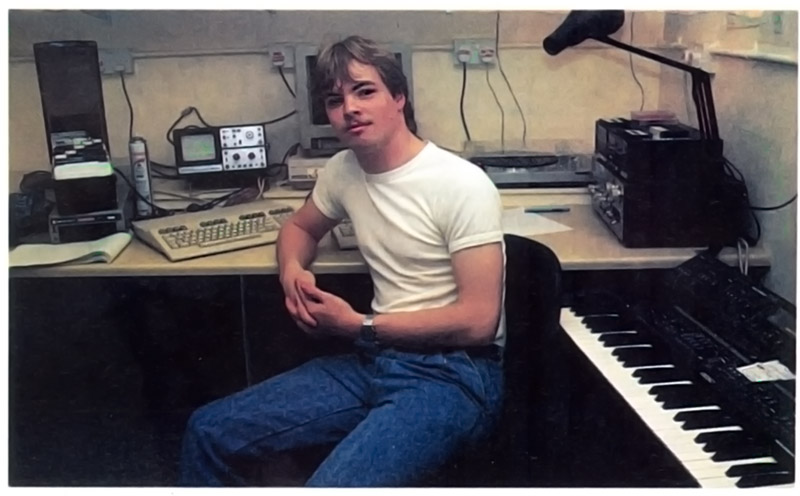
SID composer Martin Galway at Ocean in the mid-1980s
6581 R4
Identification:
Has 6581 R4 printed on the top.
Production dates:
4985 to approximately 2590
Appears in:
Commodore 64 (breadbin)
Commodore 64C/C64-II (early, long motherboard version)
Commodore 128
Commodore 128D (not DCR)
USC:
The 6581 R4 used for the USC is a 1486 (internal codename “Nuclear”) placed in an early C64C long motherboard (internal codename “Adam”) with standard 470pF filter caps. The filtering and resonance is slightly more pronounced resulting in a fatter sound than other combos when the filter is used. When the filter is not activated this combo also happens to be the cleanest, which means it is used for most tunes, including all Rob Hubbard tunes that do not apply the filter.
This “Adam”/”Nuclear” combo was the choice of Ben Daglish, Jeroen Tel (except for RoboCop 3 which is 8580), and Chordian’s choice for most of his tunes.
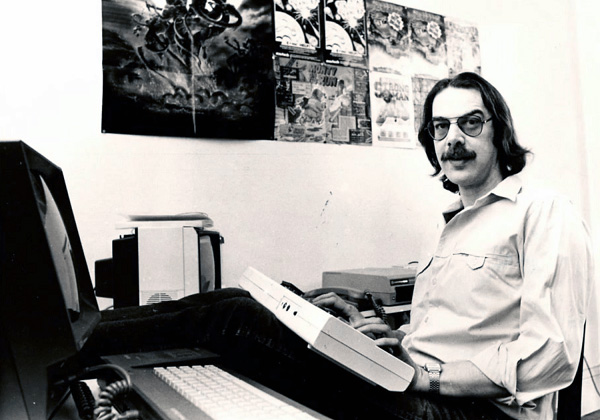
SID composer Rob Hubbard in the mid-1980s
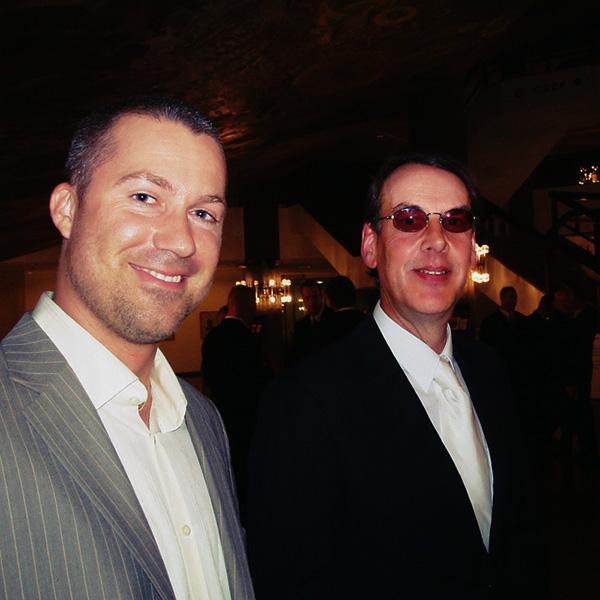
That happy smirk when you meet your childhood hero. Holger with Rob Hubbard.
6581 R4 AR
Identification:
Has 6581 R4 AR printed on top.
Production dates:
Approximately 2286 to an unknown week in 1992
Appears in:
Commodore 64/C64-II (early, long motherboard version)
Commodore 128D (not DCR)
USC:
No R4 AR were used for the USC since no improvements to the sound were found in comparison with the other chips in my possession. There are great sounding R4 ARs out there – in fact I had an R4 AR in my early C64C long board as a teenager – but none of the ARs in my USC tests were better than the other chips I tested.
6582/6582A/8580 R5
For all intents and purposes the 6582/6582A/8580 R5 are nearly identical models and are commonly referred to as merely 8580 or sometimes 8580 R5.
Some refer to the 8580 as a “revision” on par with the 6581 R2, R3, R4 and R4 AR revisions, but the design/sound differences and voltage requirements between the 6581 and the 8580 are so big that many consider them more like different “versions” of the chip.
The 8580 is favored by most modern SID composers for their new tunes since it is a much more predictable target, especially when it comes to the filter.
Identification:
Has either 6582, 6582A or 8505 R5 printed on top
Production dates:
From an unknown week in 1986 to an unknown week in 1993, about a year before Commodore went bankrupt
Appears in:
Commodore 64C/C64-II (late, short motherboard version)
Commodore 64G
Commodore 64 (Aldi)
Commodore 64GS
Commodore 128DCR (CR =cost reduced)
The 6582/6582A was meant to be for 3rd parties/OEM and mainly appears in repaired or modified machines.
USC:
The 8580 R5 (internal codename “Blue”) used for the USC was placed in a late C64C short motherboard (internal codename “Dana”) with standard 22nF caps.
If you have reached this far you should be aware that the 6581 and 8580 need different voltages and are not interchangeable in the same machine. This means you either need a dedicated C64 machine for each chip version, or you need a fully installed SIDFX 3 that allows for dual chip mounting and automatic voltage switching in a single C64.
Recapping C10+C11 in a C64 with a 6581 (LOLCAP)
Ceramic caps do not need to be changed for the same reason that electrolytes do. However, ceramic caps do age due to so-called decade loss. In a nearly 40 year old computer the ceramic caps are very likely out of whack. I have seen claims that only electrolytic caps need changing – this is incorrect.
The following fix is no miracle cure and it is only related to the filter, it will not fix dead voices. If the SID chip itself has a very muffled filter, then recapping C10+C11 might not fix it fully – although you could experiment with an even lower value than 330pF (at your own risk).
If you have a SID with a somewhat offset filter range, i.e. the lowest range seems to be overfiltered, then recapping – or rather changing the old 470pF caps to new, lower 330pF ones – will very likely address this issue.
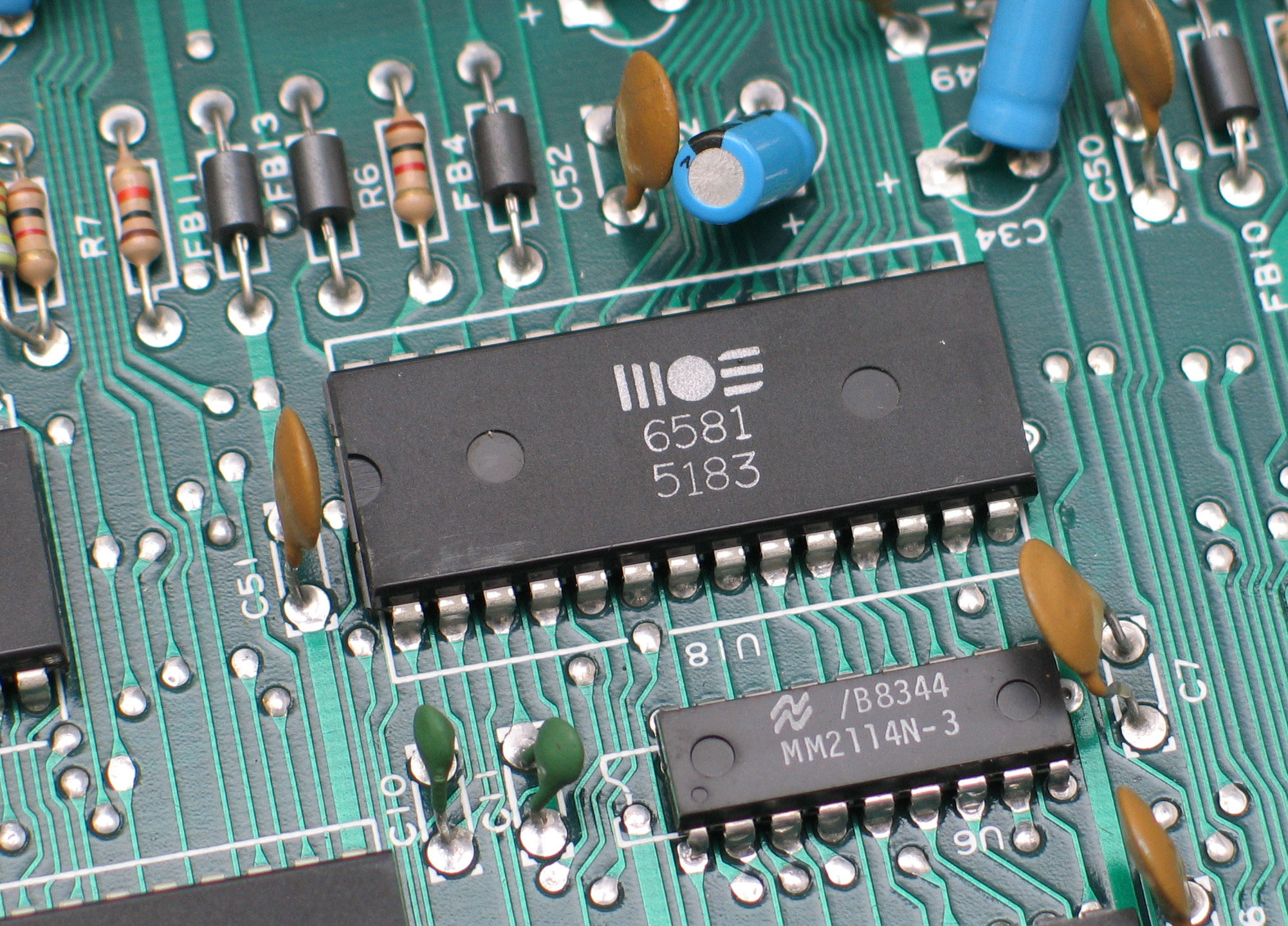
The two caps at C10+C11 (clearly marked) can be changed. Pic by Christian Taube
Fortunately changing the caps to 330pF will not significantly shift the position of the slope, but it will make it slightly steeper. Instead the main change will relatively speaking be to the filter offset, i.e. it will open up the lowest portion of the filter range quite a lot.
Because this procedure slightly shifts the slope it could be interpreted as potentially limiting the available filter range. This would be a correct interpretation if the filter was actually working properly to begin with.
However, since the range is severely limited by the sudden dropoff in the lower part of the range, this procedure will objectively expand the range far more than it will limit it or negatively affect the top of the range.
The clear effect of this tweak can be seen in the comparison screenshots further up in the “Differences between 6581 chips” section.
If you decide to look at the schematics, then it is necessary to understand that the C64 normally uses 470pF C0G caps at positions C10+C11, but higher, incorrect values are often specified in early design and repair documents (such as 1000pF and 2200pF). Actual sold C64s with 6581 chips have 470pF installed from the factory, but some were later repaired with other values.
You will need proper equipment since this procedure requires through-hole soldering. De-solder, clean, and change to 330pF C0G caps to fix the filter offset. Also consider cleaning the SID socket while you are at it. Make sure to use high quality and precision matched C0G caps. I had my electronics guy buy Kemet.
I was surprised to find so little information about this tweak on the Internet and no spectral analysis documentation of its effect – until this website. Henceforth I shall presumptuously dub this tweak the Lagerfeldt Overfilter Low Capacitor Alternative Picofarad – or LOLCAP in short.
Greetz and thanx
Everyone who has been helpful in making this project happen, even if just the tiniest – all is appreciated.
Ben Daglish (R.I.P.), Jeroen Tel, Martin Walker and JCH (Chordian) for helping me find the right C64/SID combos.
Scarzix for writing the filter test code.
Ace_45 and Idefix for helping me write the batch conversion script for PSID64.
Microtop and the Danish Historical Data Association for technical information. The rest of the Copenhagen Commodore Club/Facebook page for more technical information.
Morpheus for the background picture of Rob Hubbard’s original scores, and for always keeping the scene alive with a smile!
Macx for helping out with the PSU test, and for long philosophical discussions about beer and politics. And running a real C64 BBS in 2022.
Hippo for anti-hack support and coding a nizzle custom static WP conversion script.
SIDWave for additional information.
Rune Zetterstrøm for donating a big box of old C64 gear.
Thomas Böcker and Jan Zottmann for injecting new passion and quality standards into the retro music scene.
The Royal Danish Library for helping preserve this cultural and musical legacy for posterity.
Finally: most of all my wife who has put up with my “blip blop” music obsession for more than 20 years.
